Weijia Mao
UniRL: Self-Improving Unified Multimodal Models via Supervised and Reinforcement Learning
May 29, 2025Abstract:Unified multimodal large language models such as Show-o and Janus have achieved strong performance across both generation and understanding tasks. However, these models typically rely on large-scale datasets and require substantial computation during the pretraining stage. In addition, several post-training methods have been proposed, but they often depend on external data or are limited to task-specific customization. In this work, we introduce UniRL, a self-improving post-training approach. Our approach enables the model to generate images from prompts and use them as training data in each iteration, without relying on any external image data. Moreover, it enables the two tasks to enhance each other: the generated images are used for understanding, and the understanding results are used to supervise generation. We explore supervised fine-tuning (SFT) and Group Relative Policy Optimization (GRPO) to optimize the models. UniRL offers three key advantages: (1) it requires no external image data, as all training samples are generated by the model itself during training; (2) it not only improves individual task performance, but also reduces the imbalance between generation and understanding; and (3) it requires only several additional training steps during the post-training stage. We evaluate UniRL on top of Show-o and Janus, achieving a GenEval score of 0.77 for Show-o and 0.65 for Janus. Code and models will be released in https://github.com/showlab/UniRL.
Long-Context Autoregressive Video Modeling with Next-Frame Prediction
Mar 25, 2025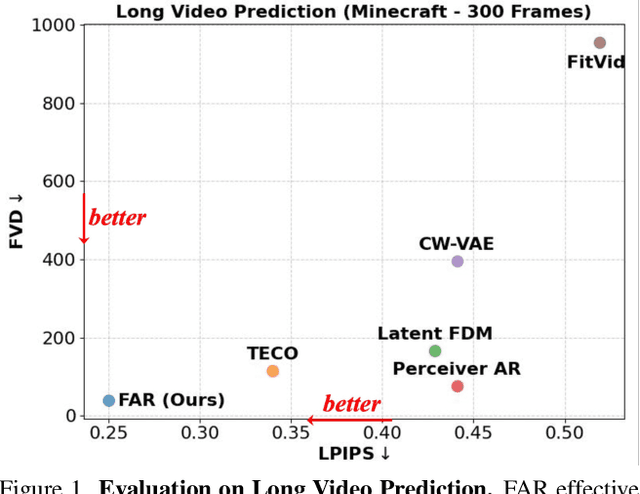
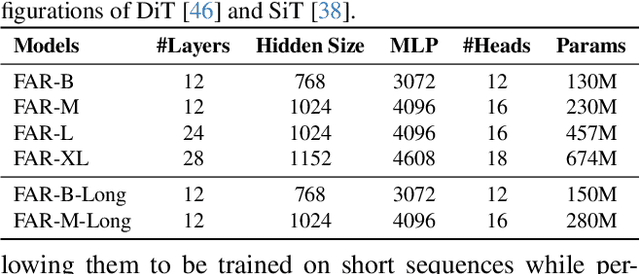
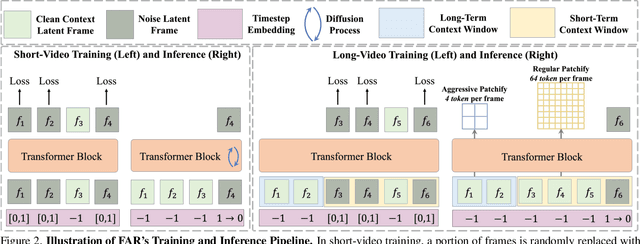
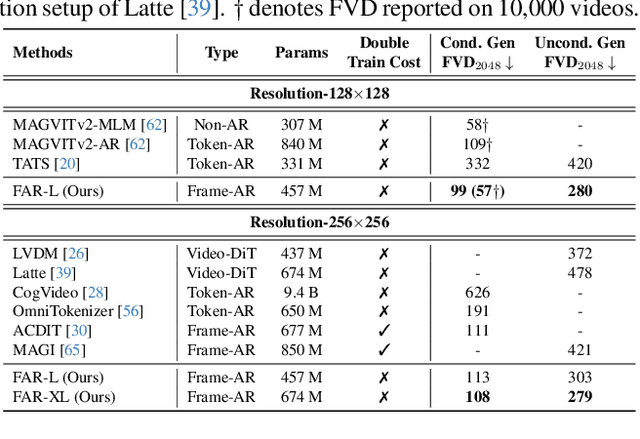
Abstract:Long-context autoregressive modeling has significantly advanced language generation, but video generation still struggles to fully utilize extended temporal contexts. To investigate long-context video modeling, we introduce Frame AutoRegressive (FAR), a strong baseline for video autoregressive modeling. Just as language models learn causal dependencies between tokens (i.e., Token AR), FAR models temporal causal dependencies between continuous frames, achieving better convergence than Token AR and video diffusion transformers. Building on FAR, we observe that long-context vision modeling faces challenges due to visual redundancy. Existing RoPE lacks effective temporal decay for remote context and fails to extrapolate well to long video sequences. Additionally, training on long videos is computationally expensive, as vision tokens grow much faster than language tokens. To tackle these issues, we propose balancing locality and long-range dependency. We introduce FlexRoPE, an test-time technique that adds flexible temporal decay to RoPE, enabling extrapolation to 16x longer vision contexts. Furthermore, we propose long short-term context modeling, where a high-resolution short-term context window ensures fine-grained temporal consistency, while an unlimited long-term context window encodes long-range information using fewer tokens. With this approach, we can train on long video sequences with a manageable token context length. We demonstrate that FAR achieves state-of-the-art performance in both short- and long-video generation, providing a simple yet effective baseline for video autoregressive modeling.
DoraCycle: Domain-Oriented Adaptation of Unified Generative Model in Multimodal Cycles
Mar 05, 2025


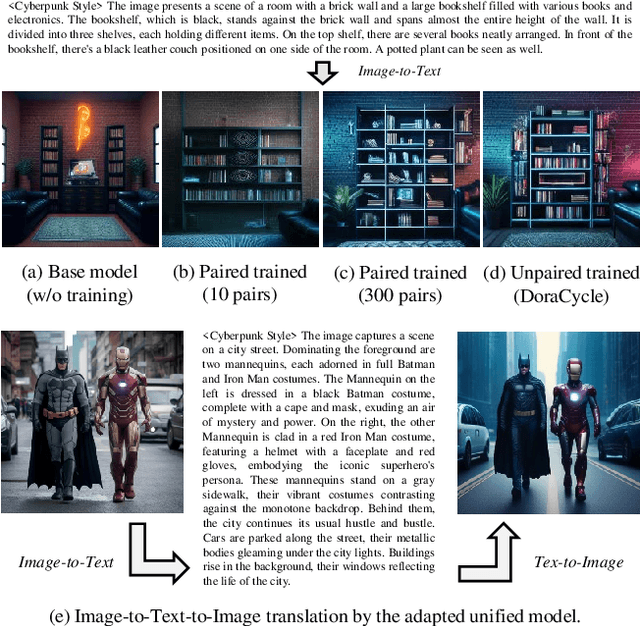
Abstract:Adapting generative models to specific domains presents an effective solution for satisfying specialized requirements. However, adapting to some complex domains remains challenging, especially when these domains require substantial paired data to capture the targeted distributions. Since unpaired data from a single modality, such as vision or language, is more readily available, we utilize the bidirectional mappings between vision and language learned by the unified generative model to enable training on unpaired data for domain adaptation. Specifically, we propose DoraCycle, which integrates two multimodal cycles: text-to-image-to-text and image-to-text-to-image. The model is optimized through cross-entropy loss computed at the cycle endpoints, where both endpoints share the same modality. This facilitates self-evolution of the model without reliance on annotated text-image pairs. Experimental results demonstrate that for tasks independent of paired knowledge, such as stylization, DoraCycle can effectively adapt the unified model using only unpaired data. For tasks involving new paired knowledge, such as specific identities, a combination of a small set of paired image-text examples and larger-scale unpaired data is sufficient for effective domain-oriented adaptation. The code will be released at https://github.com/showlab/DoraCycle.
UniMoD: Efficient Unified Multimodal Transformers with Mixture-of-Depths
Feb 10, 2025



Abstract:Unified multimodal transformers, which handle both generation and understanding tasks within a shared parameter space, have received increasing attention in recent research. Although various unified transformers have been proposed, training these models is costly due to redundant tokens and heavy attention computation. In the past, studies on large language models have demonstrated that token pruning methods, such as Mixture of Depths (MoD), can significantly improve computational efficiency. MoD employs a router to select the most important ones for processing within a transformer layer. However, directly applying MoD-based token pruning to unified transformers will result in suboptimal performance because different tasks exhibit varying levels of token redundancy. In our work, we analyze the unified transformers by (1) examining attention weight patterns, (2) evaluating the layer importance and token redundancy, and (3) analyzing task interactions. Our findings reveal that token redundancy is primarily influenced by different tasks and layers. Building on these findings, we introduce UniMoD, a task-aware token pruning method that employs a separate router for each task to determine which tokens should be pruned. We apply our method to Show-o and Emu3, reducing training FLOPs by approximately 15% in Show-o and 40% in Emu3, while maintaining or improving performance on several benchmarks. Code will be released at https://github.com/showlab/UniMoD.
Show-o: One Single Transformer to Unify Multimodal Understanding and Generation
Aug 22, 2024



Abstract:We present a unified transformer, i.e., Show-o, that unifies multimodal understanding and generation. Unlike fully autoregressive models, Show-o unifies autoregressive and (discrete) diffusion modeling to adaptively handle inputs and outputs of various and mixed modalities. The unified model flexibly supports a wide range of vision-language tasks including visual question-answering, text-to-image generation, text-guided inpainting/extrapolation, and mixed-modality generation. Across various benchmarks, it demonstrates comparable or superior performance to existing individual models with an equivalent or larger number of parameters tailored for understanding or generation. This significantly highlights its potential as a next-generation foundation model. Code and models are released at https://github.com/showlab/Show-o.
ShowRoom3D: Text to High-Quality 3D Room Generation Using 3D Priors
Dec 20, 2023Abstract:We introduce ShowRoom3D, a three-stage approach for generating high-quality 3D room-scale scenes from texts. Previous methods using 2D diffusion priors to optimize neural radiance fields for generating room-scale scenes have shown unsatisfactory quality. This is primarily attributed to the limitations of 2D priors lacking 3D awareness and constraints in the training methodology. In this paper, we utilize a 3D diffusion prior, MVDiffusion, to optimize the 3D room-scale scene. Our contributions are in two aspects. Firstly, we propose a progressive view selection process to optimize NeRF. This involves dividing the training process into three stages, gradually expanding the camera sampling scope. Secondly, we propose the pose transformation method in the second stage. It will ensure MVDiffusion provide the accurate view guidance. As a result, ShowRoom3D enables the generation of rooms with improved structural integrity, enhanced clarity from any view, reduced content repetition, and higher consistency across different perspectives. Extensive experiments demonstrate that our method, significantly outperforms state-of-the-art approaches by a large margin in terms of user study.
DynVideo-E: Harnessing Dynamic NeRF for Large-Scale Motion- and View-Change Human-Centric Video Editing
Oct 16, 2023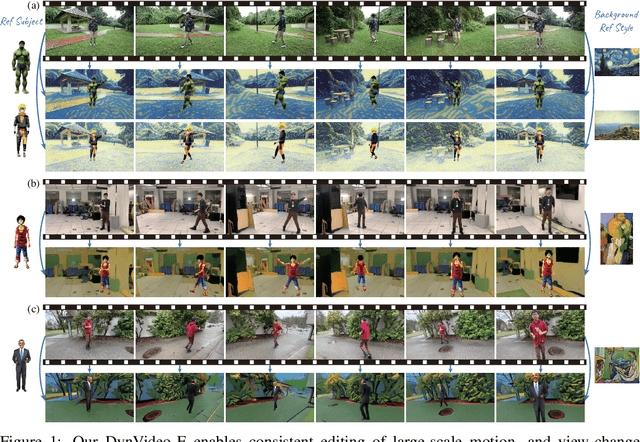

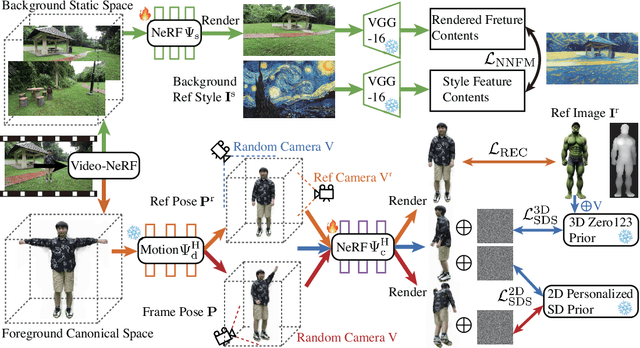
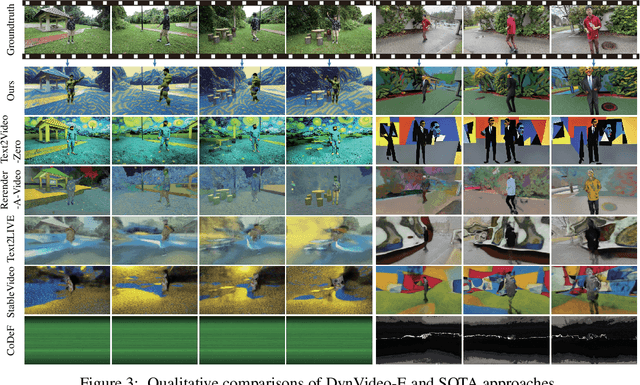
Abstract:Despite remarkable research advances in diffusion-based video editing, existing methods are limited to short-length videos due to the contradiction between long-range consistency and frame-wise editing. Recent approaches attempt to tackle this challenge by introducing video-2D representations to degrade video editing to image editing. However, they encounter significant difficulties in handling large-scale motion- and view-change videos especially for human-centric videos. This motivates us to introduce the dynamic Neural Radiance Fields (NeRF) as the human-centric video representation to ease the video editing problem to a 3D space editing task. As such, editing can be performed in the 3D spaces and propagated to the entire video via the deformation field. To provide finer and direct controllable editing, we propose the image-based 3D space editing pipeline with a set of effective designs. These include multi-view multi-pose Score Distillation Sampling (SDS) from both 2D personalized diffusion priors and 3D diffusion priors, reconstruction losses on the reference image, text-guided local parts super-resolution, and style transfer for 3D background space. Extensive experiments demonstrate that our method, dubbed as DynVideo-E, significantly outperforms SOTA approaches on two challenging datasets by a large margin of 50% ~ 95% in terms of human preference. Compelling video comparisons are provided in the project page https://showlab.github.io/DynVideo-E/. Our code and data will be released to the community.
DeVRF: Fast Deformable Voxel Radiance Fields for Dynamic Scenes
Jun 04, 2022
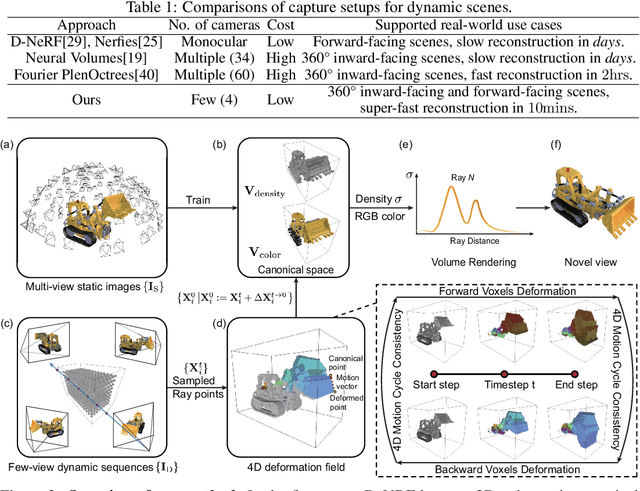
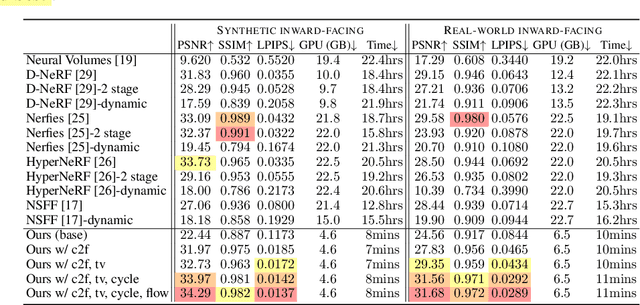
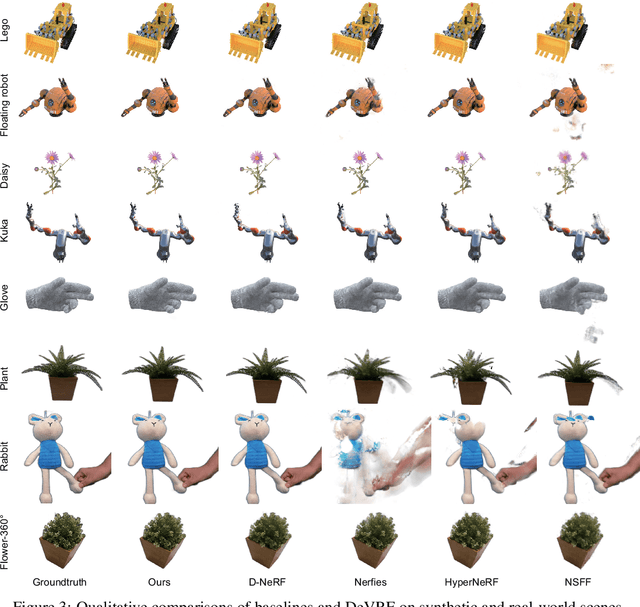
Abstract:Modeling dynamic scenes is important for many applications such as virtual reality and telepresence. Despite achieving unprecedented fidelity for novel view synthesis in dynamic scenes, existing methods based on Neural Radiance Fields (NeRF) suffer from slow convergence (i.e., model training time measured in days). In this paper, we present DeVRF, a novel representation to accelerate learning dynamic radiance fields. The core of DeVRF is to model both the 3D canonical space and 4D deformation field of a dynamic, non-rigid scene with explicit and discrete voxel-based representations. However, it is quite challenging to train such a representation which has a large number of model parameters, often resulting in overfitting issues. To overcome this challenge, we devise a novel static-to-dynamic learning paradigm together with a new data capture setup that is convenient to deploy in practice. This paradigm unlocks efficient learning of deformable radiance fields via utilizing the 3D volumetric canonical space learnt from multi-view static images to ease the learning of 4D voxel deformation field with only few-view dynamic sequences. To further improve the efficiency of our DeVRF and its synthesized novel view's quality, we conduct thorough explorations and identify a set of strategies. We evaluate DeVRF on both synthetic and real-world dynamic scenes with different types of deformation. Experiments demonstrate that DeVRF achieves two orders of magnitude speedup (100x faster) with on-par high-fidelity results compared to the previous state-of-the-art approaches. The code and dataset will be released in https://github.com/showlab/DeVRF.
Novel View Synthesis for High-fidelity Headshot Scenes
May 31, 2022
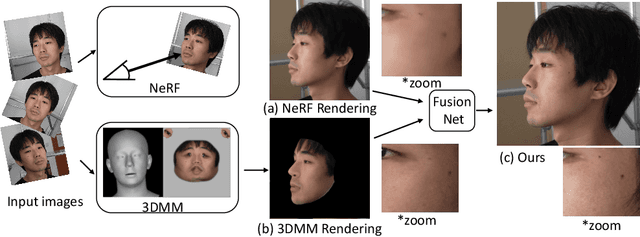
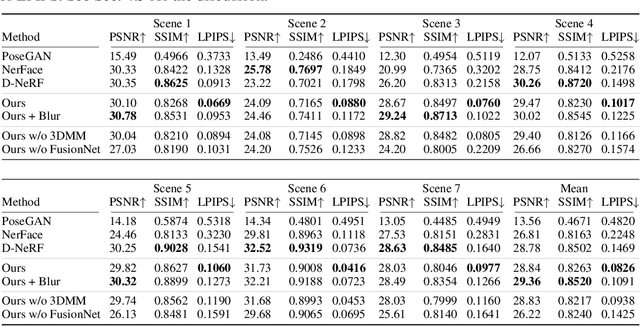
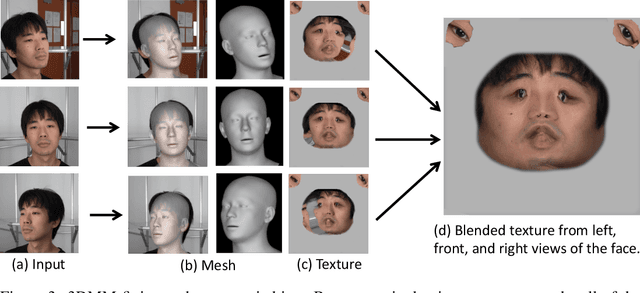
Abstract:Rendering scenes with a high-quality human face from arbitrary viewpoints is a practical and useful technique for many real-world applications. Recently, Neural Radiance Fields (NeRF), a rendering technique that uses neural networks to approximate classical ray tracing, have been considered as one of the promising approaches for synthesizing novel views from a sparse set of images. We find that NeRF can render new views while maintaining geometric consistency, but it does not properly maintain skin details, such as moles and pores. These details are important particularly for faces because when we look at an image of a face, we are much more sensitive to details than when we look at other objects. On the other hand, 3D Morpable Models (3DMMs) based on traditional meshes and textures can perform well in terms of skin detail despite that it has less precise geometry and cannot cover the head and the entire scene with background. Based on these observations, we propose a method to use both NeRF and 3DMM to synthesize a high-fidelity novel view of a scene with a face. Our method learns a Generative Adversarial Network (GAN) to mix a NeRF-synthesized image and a 3DMM-rendered image and produces a photorealistic scene with a face preserving the skin details. Experiments with various real-world scenes demonstrate the effectiveness of our approach. The code will be available on https://github.com/showlab/headshot .
 Add to Chrome
Add to Chrome Add to Firefox
Add to Firefox Add to Edge
Add to Edge